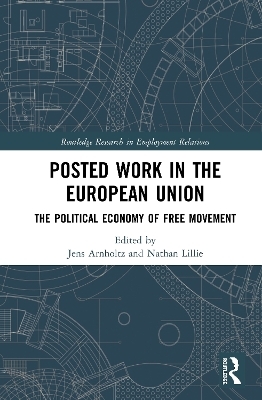
Posted Work in the European Union
Routledge (Verlag)
978-0-367-14271-1 (ISBN)
Focusing on posting of workers, where workers employed in one country are send to work in another country, this edited volume is at the nexus of industrial relations and European Union studies. The central aim is to understand how the regulatory regime of worker "posting" is driving institutional changes to national industrial relations systems. In the introduction, the editors develop a framework for understanding the relationship of supra-national EU regulation, transnational actors and national industrial relations systems, which we then apply in the empirical chapters. This unique volume brings together scholars from diverse academic fields, all of whom are experts on the topic of "worker posting." The book examines different aspects of the posting debate, including the interactions of actors such as labour inspectorates, trade unions, European legal/political regulators, manpower firms, transnational subcontractors and posted workers.
The main objective of this book is to explore the dynamics of institutional change, by showing how trans- and supra-national dynamics affect European industrial relations systems. This volume will represent the "state of the art" in research on worker posting. It will also contribute to debates on European integration, social dumping, labour market dualization and precariousness and will be of value to those with an interest employment relations, law and regulation.
Jens Arnholtz received his PhD from the Department of Sociology, University of Copenhagen. He is now an Associate Professor at the Employment Relations Research Center (FAOS) at that department. Nathan Lillie is Professor of Social and Public Policy at the University of Jyväskylä, Finland.
Acknowledgements
Chapter 1 – European Integration and the Reconfiguration of National Industrial Relations: Posted Work as a Driver of Institutional Change
Jens Arnholtz and Nathan Lillie
1.1 The socio-economic drivers of EU posting
1.2 Competing legal principles and the fundamental tension of posted work
1.3 Firm practices as the driver of change
1.4 Pressure on domestic institutions and incremental change
1.5 Enforcement actors and creative re-enactment of institutions
1.6 National institutional change in response to posted work
1.7 Feedback and European level changes
1.8 The chapters and their contribution to the argument
1.9 Conclusions
References
Chapter 2 – The benefits of posting: Facts and figures on the use and impact of intra-EU posting
Frederic De Wispelaere and Jozef Pacolet
2.1 Introduction
2.2 ‘The posted worker’: A multifaceted notion with a very concentrated impact
2.2.1 Intra-EU posting ‘at a glance’
2.2.2 The evolution of intra-EU posting
2.2.3 Some characteristics of intra-EU posting
2.2.4 The impact of intra-EU posting on national labour markets
2.3 Are we blinded by the potential negative consequences of intra-EU posting?
2.3.1 Benefits of intra-EU posting from the perspective of the Member State of origin
2.3.2 Higher wages and purchasing power for posted workers
2.3.3 Higher tax revenues from posted workers
2.3.4 Intra-EU posting as adjustment mechanism for economic shocks
2.4 Benefits of intra-EU posting from the perspective of the host Member State
2.4.1 Various motives to use intra-EU posting
2.4.2 Does intra-EU posting lead to lower costs and prices?
2.5 The more we know about posting, the better we can discuss it: Perception vs reality
References
Chapter 3 – Shifting employer strategies in light of institutional change
Kristin Alsos and Anne Mette Ødegård
3.1 The Norwegian labour market model meets a new reality
3.2 Analytical framework
3.3 Methods
3.4 First phase – 2004-2008: use of posted workers and extension of collective agreement
3.5 Second phase 2009-2013: Individual labour migrants and new court battles
3.6 Third phase 2013- 2018: The puzzle on equal treatment and closure?
3.7 Discussion and conclusion
References
Chapter 4 – Ambiguous mobility: Polish transnational workers navigating and changing the institutional landscape of posting
Anna Matyska
4.1 Transnational mobility regimes, institutions, and institutional change
4.2 Posted work and institutional ambiguity
4.3 The departure: Allowing for the ambiguity
4.4 Collaboration and compliance
4.5 From asking around to facing a state institution
4.6 Trade unionisation
4.7 Institutional navigation and incremental changes
4.8 Concluding remarks
References
Chapter 5 – A comparative analysis of union responses to posted work in four European countries
Nathan Lillie, Lisa Berntsen, Ines Wagner, and Sonila Danaj
5.1 Introduction
5.2 How does posting affect union rights?
5.3 Union responses to posted work
5.3.1 Migrant worker engagement
5.3.2 Political influence and regulatory enforcement
5.3.3 Collective agreement extension and enforcement
5.3.4 Site-level structures
5.4 Finland
5.5 The Netherlands
5.6 Germany
5.7 The United Kingdom
5.8 Analysis
References
Chapter 6 – Italian labour inspectors facing posted workers phenomena
6.1 Introduction
6.2 The instrument of posting in Italy: Sectoral and geographical trajectories
6.3 Business strategies and irregularities of posting
6.4 Labour Inspectorate' actions: Dealing with complexity
6.5 Changing regulatory framework: New approaches towards posting
6.6 Conclusion
References
Chapter 7 – Market integration, cross-border recruitment, and enforcement of labour standards – A Dutch case
7.1 Cross-border labour mobility and enforcement – Introduction
7.2 Working method
7.3 The role and function of the Dutch labour inspectorate
7.4 The Dutch instruments for enhanced compliance control based on the 2013 social pact
7.5 Assessment of the intensified compliance and enforcement policy
7.6 Business models and regulatory engagement strategies for circumventing enforcement
7.6.1 Fraudulent contracting/pay-rolling
7.6.2 Chains of subcontracting
7.6.3 Foreign legal (artificial) entities
7.6.4 Posting of workers as a labour cost-saving method
7.6.5 Regime shopping in the field of social security
7.7 The Dutch practice against the background of EU experiences
7.8 Cross-border recruitment, compliance, and enforcement – Some conclusions
References
Chapter 8 – Posting of workers: from a blurred notion associated with ‘cheap labour’ to a tool for ‘fair labour mobility’?
Mijke Houwerzijl and Lisa Berntsen
8.1 Introduction
8.2 The legal framework of intra-EU labour mobility in an enlarged internal market
8.3 Experiences and perceptions of posting in practice
8.3.1 Corporate strategies
8.3.2 Worker Perceptions and preferences regarding the employment status
8.3.4 Experiences of work and rights enforcement
8.4 Towards a comprehensive set of regulatory responses at the EU level: Enough to disassociate posting from social dumping?
8.5 Concluding remarks
References
Chapter 9 – Stepping stones over troubled waters. Recent legal evolutions and the reform of the Posting of Workers Directive
Marco Rocca
9.1 Introduction
9.2 The Reform
9.2.1 Remuneration
9.2.2 Collective agreements
9.3 Stepping stones
9.3.1 Evolving Case Law
9.3.2 Public procurement
9.3.3 The National Level
9.4 Conclusions
References
Chapter 10 – Labour Subcontracting in Cross-Border Labour Markets: A Comparison of Rule Evasion in Germany and Japan
Ines Wagner and Karen Shire
1. Introduction
2. Dispatched Work in Japan
3. The Posting of Workers Regulation and Germany
4. The Layering of Immigration and Dispatching Regulations in Japan
5. Regulatory arbitrage through Posting in Germany
6. Regulatory displacement through dispatching in Japan
7. Conclusion
References
Author Biographies
Index
| Erscheinungsdatum | 24.10.2019 |
|---|---|
| Reihe/Serie | Routledge Research in Employment Relations |
| Zusatzinfo | 2 Tables, black and white |
| Verlagsort | London |
| Sprache | englisch |
| Maße | 152 x 229 mm |
| Gewicht | 453 g |
| Themenwelt | Geschichte ► Teilgebiete der Geschichte ► Wirtschaftsgeschichte |
| Sozialwissenschaften ► Politik / Verwaltung | |
| Sozialwissenschaften ► Soziologie ► Spezielle Soziologien | |
| Wirtschaft ► Betriebswirtschaft / Management ► Personalwesen | |
| Wirtschaft ► Betriebswirtschaft / Management ► Planung / Organisation | |
| Wirtschaft ► Volkswirtschaftslehre ► Wirtschaftspolitik | |
| ISBN-10 | 0-367-14271-6 / 0367142716 |
| ISBN-13 | 978-0-367-14271-1 / 9780367142711 |
| Zustand | Neuware |
| Informationen gemäß Produktsicherheitsverordnung (GPSR) | |
| Haben Sie eine Frage zum Produkt? |
aus dem Bereich


